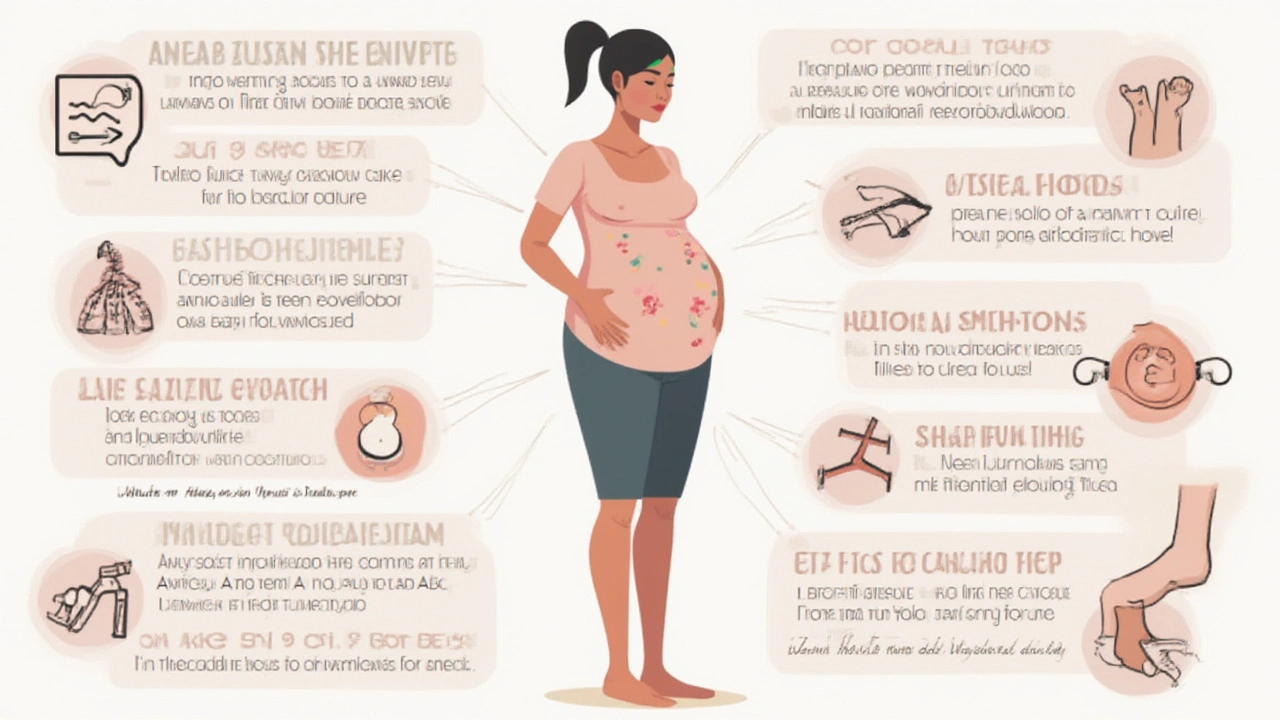 Jul, 21 2025
Jul, 21 2025
If you hear the words “pregnancy swelling,” a lot of people think of those last few months, when ankles are the size of apples and shoes just don’t fit anymore. But here’s the kicker: swelling, or edema, can show up much earlier—and in way more places than just your feet. Nearly 8 out of 10 pregnant women notice some swelling, especially after standing all day in the summer heat. It’s just one more thing on the wild list of body changes, but the trick is telling what’s normal, what’s weird, and how you can keep it from driving you up the wall.
Why Does Swelling Happen During Pregnancy?
The biggest reason your feet (and sometimes your fingers and face) puff up during pregnancy? Blood volume. By about week 28, your body has about 50% more blood and fluids sloshing around than it did before you got pregnant. That extra fluid is doing important stuff—it helps your baby grow, brings more oxygen, and prepares your body for labor. But it doesn’t always stay put. Gravity pulls it into your lower legs, especially late in the day or when the weather is hot.
There’s another culprit too: hormones. Progesterone relaxes the blood vessel walls, which means more fluid leaks out into tissues. Plus, your growing uterus puts the squeeze on the big veins in your pelvis, making it harder for blood to zip back up to your heart. The result? Your calves, ankles, and feet become bottlenecks for fluid.
This is why a lot of women notice that their favorite sneakers or wedding rings don’t fit as pregnancy swings into the second and third trimesters. And if you’re stuck in hot, humid weather or have to stand for long hours, swelling just piles on.
| Body Part | When It Swells Most |
|---|---|
| Feet & Ankles | Late afternoon, after activity |
| Hands | After walking, mornings in 3rd trimester |
| Face | Upon waking or due to hormones |
| Legs | Any time after 5th month |
Here’s a fact that often surprises people: swelling can even get worse right after giving birth. Your body starts dumping all that extra fluid you carried, and sometimes it takes a week or more to feel like yourself again.
Another interesting note: mild swelling tends to go up in summer or if you’ve been standing a lot. It can also get worse if you eat food that’s salty or processed. If you’re one to reach for chips or pickles (hey, pregnancy cravings are real!), keep this in mind.

When Swelling Becomes a Red Flag
Most of the time, pregnancy swelling is no big deal. You’ll notice it more at the end of the day, and it’ll usually calm down after resting or sleeping. But, there are a few scenarios where it’s time to pay attention—and maybe call your doctor.
- The swelling comes on super suddenly, like you wake up one day and can’t get your ring off or your face is noticeably rounder.
- Bumps up fast after the 20th week, especially with headaches, vision changes, or pain in the upper right side of your belly.
- You notice swelling that’s only on one leg or foot, or it’s red, hot, or painful.
- It doesn’t go down overnight or after putting your feet up.
These can be signs of serious conditions like preeclampsia (a condition that affects blood pressure and kidney function) or deep vein thrombosis (a blood clot in the leg). Quick stat: around 5–8% of pregnant women develop preeclampsia, and severe or sudden swelling is one of the earliest tip-offs.
Don’t stress every little puffiness, but if the swelling feels extreme, or you just have a gut feeling something’s off, get checked out. Most doctors would rather hear about it and tell you it’s all good than miss something serious.

How to Cope: Small Changes, Big Relief
So, what can you do (besides inventing anti-gravity boots)? The good news: you don’t have to just sit there and suffer. There are real, proven ways to fight swelling—a few come straight out of research, and a bunch are tried-and-true tricks from people who’ve actually gone through pregnancy.
- Put Your Feet Up: Take breaks to elevate your legs above your heart—prop them on pillows, the arm of the couch, or the end of the bed. Shoot for 2–3 times a day, even if just for 15–20 minutes.
- Move Around: Don’t stand or sit for too long. Every 30–60 minutes, take a walk, stretch, or even just flex your feet up and down to keep blood moving.
- Stay Hydrated: It feels weird, but drinking more water actually tells your body to flush out salt and extra fluids. Shoot for about 8–10 cups a day, unless your doctor says otherwise.
- Watch Your Salt: No need to eat plain lettuce for nine months. Just be mindful of processed foods and those hidden salt bombs like ramen, canned soup, and fast food.
- Wear Supportive Shoes: Skip heels and narrow shoes. Pick footwear (or sandals) with cushy soles and enough room for foot expansion.
- Compression Socks: These aren’t just for airline pilots or grandmas. Good quality support stockings can stop swelling from crawling up your legs—just ask your provider for the right type and fit.
- Sleep on Your Left Side: This takes pressure off the big vein carrying blood back to your heart and your kidneys. Plus, it might help your back, too.
- Mind the Heat: Steamy baths, hot summer walks, and long car rides can all make swelling worse. Keep it cool, and if you’re stuck outside, try to find shade or take breaks indoors.
Some people swear by foods high in potassium like bananas, sweet potatoes, or spinach to help, and there’s a bit of science to back this up. Potassium helps balance out sodium in your system, which keeps fluid from pooling in your tissues so much. You also get bonus points for extra fiber (pregnancy constipation is another topic, but trust me, they’re related).
If you want concrete steps to try at home, here’s a quick routine:
- After dinner, put on a cool, damp washcloth across your ankles and put your feet up for 20 minutes.
- Drink a glass of water with lemon or cucumber slices to boost hydration.
- Before bed, do ten gentle foot circles and a few ankle rolls while lying down.
- Sleep with a pillow under your feet to keep them slightly raised all night.
Most people find a combo of these little changes help. Consistency is the key. And if you live somewhere steamy or are in your third trimester in July, give yourself a break. Swelling is common, not a failure, and absolutely not a reason to panic unless it fits the red flag signs.
| Tip | Benefit |
|---|---|
| Elevate Feet | Reduces gravity-driven buildup |
| Compression Stockings | Supports veins and reduces pooling |
| Stay Cool | Limits heat-triggered fluid shift |
| Hydrate | Flushes excess salt and water |
| Move Every Hour | Makes blood return easier |
Curious about what’s totally not normal? If your shoes don’t fit but your hands, face, and tongue are super swollen, or if you have trouble breathing or crushing headaches, those need medical attention. Don’t feel silly asking. There are no stupid questions in pregnancy, just little mysteries waiting for sage advice (and sometimes, medical science).
Swelling is the price of admission for growing a new human. For almost everyone, it’s safe, temporary, and annoying. If you’re rocking “cankles” or puffy toes this summer, you’ve got lots of company. Keep up with the small tweaks, trust your gut, and remember—this is your pregnancy swelling journey, no one else’s. You’ve got this.
Chelsey Gonzales
July 23, 2025 AT 04:18my feet looked like two overinflated balloons by week 24 and i just wore flip flops for 3 months straight 😅 no shame in the game
Natalie Sofer
July 23, 2025 AT 11:54i remember thinking my rings were stuck forever but they popped off after delivery like magic. also, drinking water felt counterintuitive but it really helped-my ankles stopped looking like dumplings by week 30
Tiffany Fox
July 23, 2025 AT 17:55compression socks are a game changer. not sexy, but worth it. also sleep on your left side-even if you roll over 17 times a night, try to start there
Rohini Paul
July 24, 2025 AT 22:34in india we call this ‘puffiness’ and grandma says eat more coconut water and avoid curry at night. honestly? it works. also, walking barefoot on cool tiles helps more than you think
Courtney Mintenko
July 25, 2025 AT 22:06so we’re just supposed to accept that our bodies are now leaky vessels designed by someone who hates comfort? thanks biology. also why is everything ‘normal’ until it’s not? why can’t they just give us a flowchart
Sean Goss
July 27, 2025 AT 06:21the data on edema in pregnancy is statistically significant but poorly contextualized. the fluid retention is a direct result of RAAS activation and venous compliance modulation. also, potassium intake is negligible compared to sodium load. fix the diet first
Khamaile Shakeer
July 27, 2025 AT 22:44lol i ate 3 bags of chips daily and still had ‘cankles’ 🤦♂️😂 also, my wife said ‘drink water’ and i said ‘but i’m already a walking lake’ 😭
Suryakant Godale
July 29, 2025 AT 06:33It is imperative to note that the physiological alterations associated with gestational edema are primarily mediated by hormonal fluctuations and mechanical compression of the inferior vena cava. A structured regimen of positional modification and hydration is empirically supported in clinical literature.
John Kang
July 30, 2025 AT 17:32you got this. even if your socks leave marks and your shoes are in the closet, you’re doing amazing. just move when you can, sip water, and rest when you can. no one expects perfection
Bob Stewart
July 30, 2025 AT 18:07Hydration levels must be monitored in relation to serum osmolality and urinary output. While anecdotal evidence supports increased water intake, controlled trials indicate marginal benefit unless baseline hydration is deficient. Also, compression garments should meet ASTM standards for graduated pressure.
Simran Mishra
July 31, 2025 AT 13:28i remember one night i woke up and my face was so swollen i looked like a pufferfish and i cried for an hour because i thought i was dying and then i Googled it and found out it was normal but then i couldn’t sleep for three nights because i kept touching my cheeks and wondering if it was going to get worse and now i’m scared to even drink water because what if it makes it worse and i don’t know if i can handle another week of this
ka modesto
August 2, 2025 AT 10:29the banana trick works. i ate one every morning and my hands didn’t swell as bad. also, cold cucumber slices on your eyes when you’re tired? instant relief. you’re not alone, mama
Holly Lowe
August 2, 2025 AT 19:27swelling is your body throwing a rave and inviting every fluid molecule it can find. wear your comfiest socks like armor, dance in your kitchen, and remember: you’re not bloated-you’re *biologically majestic*
Cindy Burgess
August 4, 2025 AT 06:07While the article presents a comprehensive overview, it lacks citations from peer-reviewed obstetric journals. The recommendation to consume potassium-rich foods is not substantiated by RCTs specific to gestational edema. Further methodological rigor is warranted.
dayana rincon
August 5, 2025 AT 19:52so you’re telling me i can’t blame my shoes anymore? 😏
Orion Rentals
August 6, 2025 AT 00:59The physiological mechanisms described are consistent with current clinical guidelines. I appreciate the inclusion of both evidence-based and experiential recommendations. This is a well-balanced resource for expectant individuals.
Sondra Johnson
August 7, 2025 AT 10:13my ankles looked like they were stuffed with bread and i still wore heels to my baby shower. i’m a legend. also, if you’re not wearing compression socks, you’re basically fighting gravity with your bare hands. get the socks. you’ll thank me later